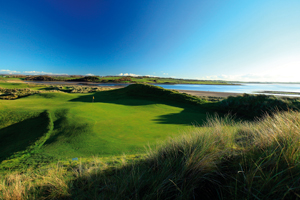Golfer's Guide to Ireland
Despite its rich seam of top-quality golf, one region of Ireland tends to get overlooked. Rob Smith heads up the relatively undiscovered western coast to see what he has been missing...


Having enjoyed my fair share of golfing trips, for many years there had been one particular destination which had somehow escaped my turf-damaging attentions. Think of Ireland as a clock face, and we are looking at the coastline between 9 and 12 - from the counties of Galway up to Donegal - or in golfing terms, from Connemara up to Ballyliffin. Packed with enticingly named clubs, this genuinely breathtaking countryside is both blessed and cursed by its relative remoteness. In late September I embarked on an ambitious odyssey to play a number of its courses, three of which are in the current Golf Monthly Top 100, five which feature in the Next 100, and a couple more which were included in December's 100 Hidden Gems special.
The West of Ireland Airport at Knock is an ideal place to start as, although enjoying a major upgrade, it is quiet and handily situated less than an hour from Galway and Sligo. I headed south to the former, an important tourism centre which acts as a gateway to the scenic splendour of the county. After an excellent dinner at the quayside Ard Bia restaurant and an early night, I was looking forward to my first port-of-call, the wild and rugged links at Connemara.
If ever there was an appetite-whetting drive, the road from Galway is it. As you head through evermore glorious scenery into what could easily pass as the middle of nowhere, you wonder whether there really will be a golf club waiting at the end. But of course there is, and clearly the pilgrimage is one that golfers are keen to make. The main championship loops are the older A and B nines, designed by Eddie Hackett in 1973, and I played these in front of two New Yorkers who told me they had never seen golf in such an amazing place. The ‘three-club wind' probably counts as a still day at Connemara, and following an excellent opening hole, the next few are less dramatic before things take off from the 8th. The back nine is full of variety with great views, tempting drives and plateau greens. The short 13th is an outstanding, natural par 3, and following a rare birdie at 14, I was even more pleased with my par at the tough 16th as it included a drop from the burn which guards the green. And so it begins...
As you head over the hill and get your first glimpse of the dunes at Enniscrone, you know you are in for something special. I played with club manager Pat Sweeney, a knowledgeable host whose habit of using the putter for anything from within 150 yards is slightly unnerving at first. This Hackett design enjoyed some substantial modifications by Donald Steel about ten years ago to make more use of the dunes and is now seriously good. Following a hugely deceptive opening drive into an area that makes the 1st at St Andrews look tight, the course heads into, along, out of, and back through the dunes. It is bursting with character, infinitely varied, and a course I cannot wait to play again. I particularly liked the 9th along the estuary and the back-to-back short par 4s at 12 and 13, whilst the 15th is so tough being stroke index one simply doesn't do it justice.
The approach to Carne, just beyond the coastal town of Belmullet, again makes you feel you are entering uncharted territory. Following a tough opening hole, the following few holes are fine enough but perhaps less striking. However, from the unusual par-3 7th to an elevated green, things just get better and better as the drama really unfolds at the start of the back nine. This opens with an outstanding par 5 up and through dunes, before an awe-inspiring tee shot between two more towering sand hills at the next. The closing six holes are all superb with the last four bordering on sublime. This was Hackett's last design and is a fitting testament to one of golf architecture's leading figures. There is an ongoing project to finish another nine through the dunes; when this is done, it will be a must-play. To be fair, it is already.
County Sligo, known as Rosses Point, was the only course I had played before and I was keen to return as it has lived fondly in my memory. Being a Colt fan, I am always keen to play his courses and with the exception of the opening three holes, this is another gem. The 4th is a perfect example of a short hole that doesn't need bunkers, whilst the 9th is an equally fine example of one that benefits from them. Elsewhere, the views of the Ox Mountains and the golfing test are outstanding. When you reach the far end, you really feel as though you are in a different world. Standing on the tee of the short 13th, I was surprised to recall the shank I had hit onto the beach in 1992. Isn't it odd how history repeats itself? Stroke index 2, the 17th is a great example of a bunkerless - but still very demanding - par 4. The course is every bit as good as I had remembered and I hope it will be less than 19 years before I return again.
It is now Sunday morning on the west coast of Ireland. It is October, the sun is shining, and there isn't a breath of wind. I am suspicious! However, I have no need to be as I emerge through the forest to the Donegal club at Murvagh, yet another exquisitely situated Hackett design. Today we are on a lush promontory to the south of the county town, and once again I am nothing but impressed by what lies ahead. The course consists of two loops of nine; perhaps presented the wrong way round as the front nine is more attractive and dramatic than the back. However, this is a minor quibble as once again there is a superb array of golf on offer surrounded by yet more mountains and seascapes. Afterwards, I enjoyed a Guinness with four members and got the impression that this is a very friendly place to play.
Get the Golf Monthly Newsletter
Subscribe to the Golf Monthly newsletter to stay up to date with all the latest tour news, equipment news, reviews, head-to-heads and buyer’s guides from our team of experienced experts.

Rob has been playing golf for over 45 years and been a contributing editor for Golf Monthly since 2012. He specialises in course reviews and travel, and has played over 1,250 courses in almost 50 countries. In 2021, he played all 21 courses in East Lothian in 13 days. Last year, his tally was 78, exactly half of them for the first time. One of Rob's primary roles is helping to prepare the Top 100 Courses of the UK&I, of which he has played all, as well as the Next 100 where he is missing two in Scotland and two in Ireland. He has been a member of Tandridge for over 30 years where his handicap hovers around 15. You can contact him at r.smith896@btinternet.com.
-
 'Welcome To The Club' - Tiger Woods Leads Praise For Rory McIlroy After Masters And Grand Slam Glory
'Welcome To The Club' - Tiger Woods Leads Praise For Rory McIlroy After Masters And Grand Slam GloryA host of famous sports stars and celebrities have been quick to praise the Northern Irishman after his incredible victory at Augusta
By Michael Weston Published
-
 'He Wouldn't Talk To Me' - Bryson DeChambeau Reveals Rory McIlroy Dynamic During The Masters Final Round
'He Wouldn't Talk To Me' - Bryson DeChambeau Reveals Rory McIlroy Dynamic During The Masters Final RoundAfter a disappointing Sunday at The Masters, DeChambeau shared that McIlroy was so focused en route to victory that the pair barely exchanged words all day
By Jonny Leighfield Published